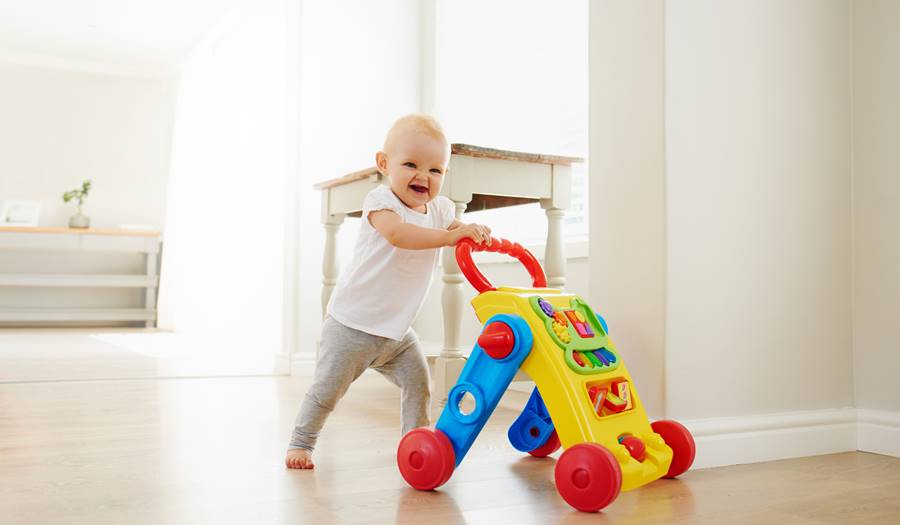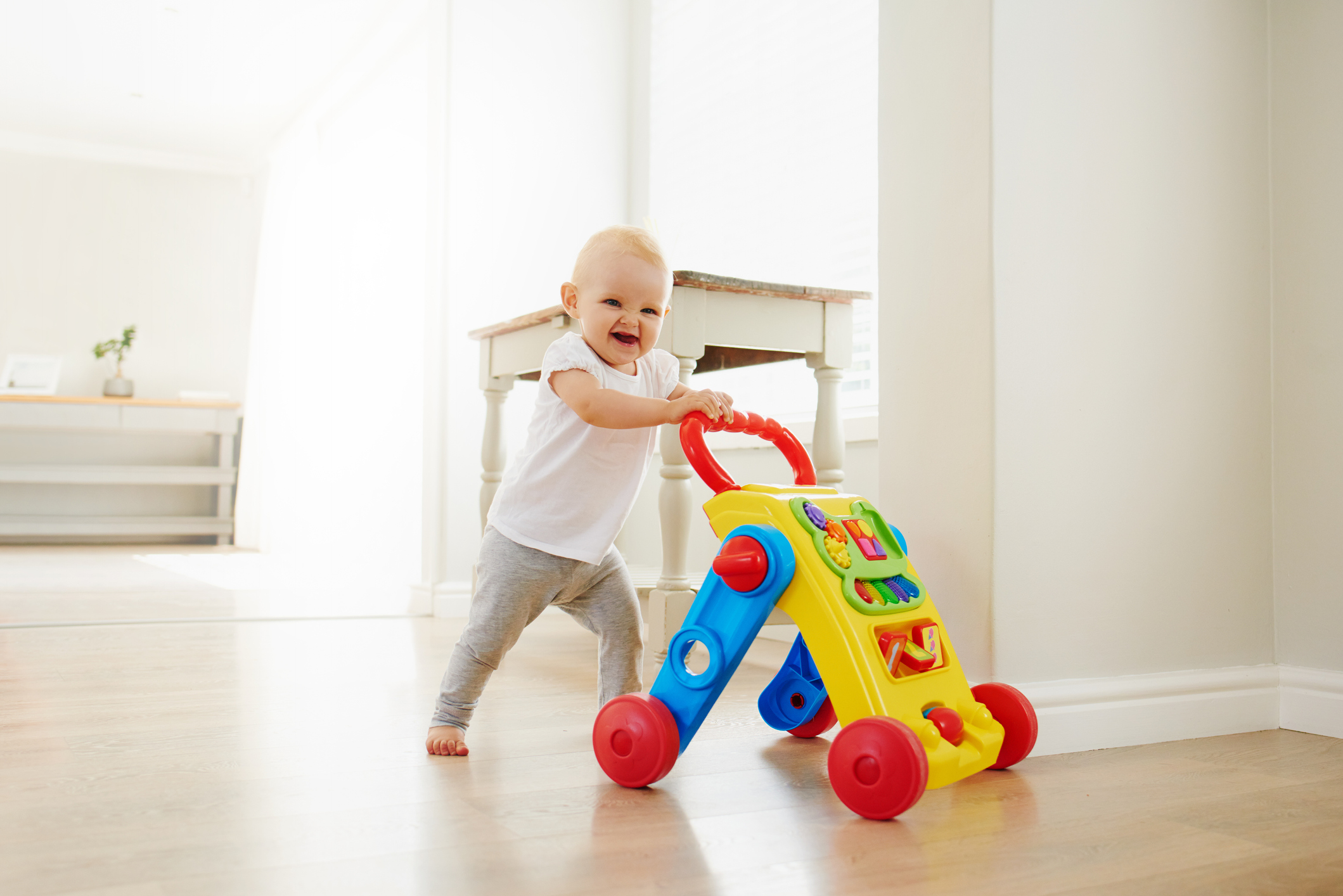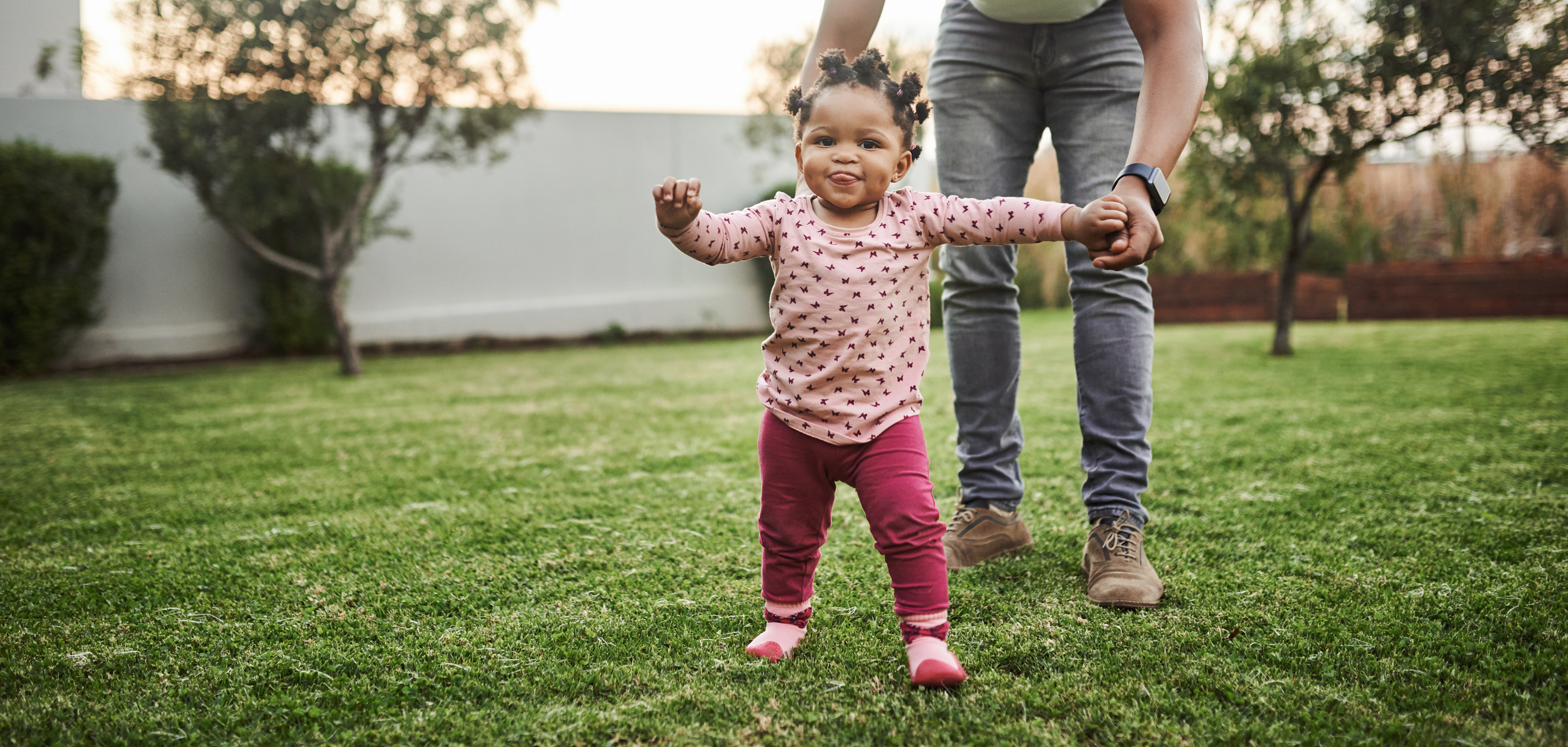
Walking and First Shoes
12/13/2021

Milestones are exciting points in your baby’s life where they will develop a new skill. What will be their first word? When will they take their first steps? But with those milestones can come some worries! Is my child developing as they should? Are they walking weirdly? This week we will learn about the walking milestone. We will learn the skills you need to walk and how to practice pre-walking skills that help your baby learn to walk. We will also learn about different issues that may present and what to look for in your child’s first pair of shoes.
First Steps
Most children take their first steps around their 1st birthday, but first steps can happen anywhere between 9 and 18 months! All children develop differently and will start walking at different times. Research has found the time of first steps does NOT relate to later motor development or cognitive ability. If your child is not walking by 16 months, this should be addressed with your pediatrician so they can be evaluated and start any recommended intervention.
Pre-walking Skills
Your child cannot start walking until they have developed certain skills. What skills do children need to have in order to walk? They need:
- Good core muscles
- To be able to activate core muscles
- Balance
- Hip and leg strength
- Postural stability or the ability to try to keep their head over their body
- Hip righting—when standing they move hips forward and back to maintain balance–it looks like surfing
- Ankle righting—rocking back and forth on feet to get balance, may include gripping with toes
- Protective reflexes- putting hand out when falling
The above skills are practiced through play and through reaching other milestones of gross motor development. Most kids reach the following pre-walking milestones before walking:
- Pulling to stand using their hands
- Cruising holding on to furniture/objects
- Standing on their own for 30 seconds
- Transitioning in and out of standing (able to sit down without falling from standing position)
- Taking steps when holding on to you or a toy
- Taking steps with a push toy
Walking
It can take up to 3-6 months for a child to develop a mature walking pattern. That means your child’s walk my look funny in those first few months! New walkers are called ‘toddlers’ because of the way they walk…they toddle from one leg to the other with their legs far apart!
While they are working on building up ankle stability, finding their equilibrium and balance, and adjusting to standing, they may compensate. It is normal for your child to:
- Wobble side to side
- Walk with their stomach pushed out
- Walk with their bum pushed out
- Hold their arms up (like goal posts) or out (zombie walk)
- Keep knees bent
- Not use a heel to gait
- Claw at the floor with their toes
- Take bigger steps with one side
- Hesitate between steps
- Need to get their balance between steps
After 3-4 months, a new walker’s gait takes on a more mature gait pattern. They will have their hands at their side. Their feet will be close together and move in a heel to toe step. They will also be able to stop, pick up an object and carry an object. They may also be able to climb stairs and pull a toy behind them.
Encouraging Walking
The most important way we can encourage our children to walk is to allow lots of time for play. A child should never sit for longer than 1 hour when not sleeping and should get a minimum of 1 hour of free play daily. Also, you should minimize time in containers such as walkers or jumpers as these inhibit development.
Allow daily play in a big open area. Make sure toys are spread out and on different levels (such as on floor, on coffee table, on couch) to encourage movement. It can also be helpful to have a push toy (even a diaper box works) available for play. Push toys encourage upright walking, build up leg and ankle strength, promote back extension, result in slower walking, and allows weight to be shifted into the heel to promote a heel to toe step. They do not cause toe walking. If the push toy moves to fast, use small weights to slow it down. Here are some toy suggestions.
If possible, adding in 30 minutes of directed play with your child can help work on skills necessary for walking. These may include:
- Using pillows, blankets, toys, and tunnels to make an obstacle course
- When your child is standing and playing, sit behind them holding a toy for them to turn and reach for—this helps strengthen ankles and the core and works on balance
- Having your child sit on your leg and move into a standing position by holding toy or balloon over their head
- Standing with support on soft surfaces such as pillows or blankets
- Supported walking
- Holding your hands but with your hands below their shoulder level
- Holding below their shoulders or on their shoulders
- Supported walking hold onto a toy, balloon, or hula hoop that you are holding
- Work on single leg play meaning play where they bear weight in just one leg-this strengthens hip muscles and helps your child control their steps
- Have your child step over your legs while holding your hands
- Have your child stand holding on to your hands or a surface but with one foot up on a pillow or a book or your leg
First Shoes
Once your child is walking you will need to consider getting them their first pair of shoes. Shoes should NOT be worn when learning to walk. They should be used only for safety and when walking outside of the house.
Barefoot is the best way to learn to walk! By being barefoot your child develops their ankle muscles, strengthens their toes, and works on balance and coordination. Barefoot walking also helps with arch development and provides important sensory input.
Despite barefoot being best, shoes may be used if your child has a gait issue or delayed development that could be helped or corrected with shoes. This group includes children who have not starting walking after 4-5 months of cruising or children who are toe walking past the age of 2. But this is a decision to be made with a provider and a physical therapist.
Importance of Good Footwear
Picking out a good shoe is VERY important to the health of your child’s feet. Over ¼ of the bones in the human body are in the feet! The majority of bone development occurs before the age of 7. Children’s foot bones are mostly cartilage that develops into bone during these 7 years. A poor fitting shoe worn during this development can permanently warp the foot bones. Children also produce twice as much sweat as adults. This makes them more prone to movement in the shoe which increases instability. It can also result in blisters.
What do we want in a shoe? We want:
- A soft, flexible sole
- A stiff or rigid heel cup for balance/stability
- A wide toe box so toes can spread
- A lightweight shoe
- An ankle strap (Velcro is nice to help ensure good fit)
- Traction on the bottom of the shoe
- A breathable material to help reduce moisture/sweating
What should you avoid?
- A slip-on shoe (this means crocs, flip flops, slip on sneakers)
- Plastic or non-breathable material
- High cost (shoes may need to be changed every 8-12 weeks due to growth)

Abnormal Gaits
New walkers can have abnormal gaits, but their gait should improve over the first few months. But what should you be looking for?
Bowlegs
Being bowlegged is when your knees are further apart than your ankles when your ankles are together. This is normal until age 2. It is more common to see in early walkers as their legs have not had as much time in a standing position to use weight bearing to reshape and straighten their legs.
Bow leggedness doesn’t need to be evaluated unless it persists past age 2 or 3, involves one leg being much more bowed than the other, is causing pain, or is impacting function. This means it is causing tripping, falling, or walking on the outside of the feet.
Pronation
Pronation is how feet and ankles bear weight. Pronation should be neutral. Abnormal pronation includes supination (when ankles and feet lean out) or excess pronation (when ankles and feet lean inwards onto the arch). Supination and pronation are common to see in the first 3 months of walking but then should resolve. If it lasts longer than 3 months or if your child has a history of hip issues or concerns, it is very significant on one side only, causes discomfort, or causes limp, it should be evaluated by your provider.
Sometimes excess pronation can cause issues with walking. It can cause out toeing (see more below). How can you tell if your child has excess pronation? It can be hard due to toddlers’ bowlegs and fat pads in the arch area. Children who have excessive pronation that needs to be addressed may have knees that come together when squatting (meaning their knees come inward instead of outward). These children may not walk despite cruising for 4-5 months. They also may be noted to be balancing on the inside of their feet when standing with the outside of the foot lifting off the floor. Children with excess pronation may also not tolerate rigid shoes as they cause discomfort.
If your child has excess pronation, they may need and evaluation and physical therapy to help address any ankle weakness. They may also benefit from rigid shoes with a good, structured heel, arch support, and a straight sole (not curved or semi-curved). Shoes with an arch support or ankle support (like high tops) may be beneficial. A physical therapist or orthopedist may also recommend a specialized insert.
In and Out Toeing
In- and out-toeing are changes to the direction of the feet when walking meaning turning in or out and not facing straight forward. If present, it generally goes away with in 3-4 months of learning to walk. It is only an issue if causing excessive falling, tripping, pain, or other gross motor delays. In- or out- toeing should be discussed with your child’s provider.
In-toeing
In-toeing is when a child walks with toes pointed inwards. They may also drag their toes when walking and not fully extend their knees. This can be caused by several different issues including misalignment, weakness, or tightness in ankles, knees, or hips, metatarsus adductus (when the front part of the foot turns inwards because the bones are turned inward), leg length discrepancy or neurological issues.
Out-toeing
Out-toeing is when a child walks with their toes pointed outward. Often this is the result of poor ankle alignment, flat feet, excess pronation, muscle weakness, or increased joint mobility. It can cause delays in walking.

Exercises
If your child is in- or out-toeing, you can help them by working on strengthening their big leg muscles. This will help with their balance. Typical exercises include:
- Any of the single leg play exercises noted above
- Playing with ride on toys (getting on and off these toys helps build strength)
- Stomping
- Stepping up or climbing stairs sideways
- Backwards walking
- Playing in a squat position
- Climbing
- Making a bridge with their body or crab walking
- Grabbing things with toes
- If your child is in-toeing have them move it from a center spot out towards the side
- If your child is out-toeing, have them move things from the side into a center position
Toe Walking
Toe walking is when a child walks on the balls of their feet without their heel contacting the floor. Children sometimes toe walk for stability because when they lock out their joints, their leg becomes more stable. It is common among new walkers. Prolonged toe walking can be the result of neurological issues, sensory integration issues, atypical muscle tone (too tight or not enough muscle tone), visual field impairments (depth perception/strabismus), range of motion issues of the leg or foot, or even habit.
When do we worry about toe walking? If your child is over the age of 2, if they toe walk more than 80% of the time, or toe walk for more than 4 straight weeks they should be evaluated. An evaluation is very important because most children will not outgrow toe walking, especially if it has been going on for more than 6 months. They will need physical therapy to improve their gait and mobility.
Prolonged toe walking can result in back, knee and ankle pain, withdrawal from activities due to pain, and the inability to jump, climb stairs or squat. A child who walks on their tip toes for a prolonged time may have overdeveloped or large calves, heel cord tightness, or foot deformities.
Exercises
If your child isn’t at the point where they need an evaluation, but you are worried about toe walking, there are some exercises that can help. These include:
- Walking backwards
- Duck walking
- Playing in a squatting position
- Picking up items with toes
- Sitting and pulling their body with their heels
- Walking and touching their heel to an elevated object (like on a balance beam or container)
- Walking up inclines like wedge play mats or slides
- Stepping in and out of low containers (4-6 inches tall)
- Stretching using body weight
- Calf stretches
Walking is an important milestone. Free play in an open area encourages your child to move and explore their environment. If you are concerned about your child’s development or gait, please do not hesitate to discuss this with your provider.
Children’s Health Care of Newburyport, Massachusetts and Haverhill, Massachusetts is a pediatric healthcare practice providing care for families across the North Shore, Merrimack Valley, southern New Hampshire, and the Seacoast regions. The Children’s Health Care team includes pediatricians and pediatric nurse practitioners who provide comprehensive pediatric health care for children, including newborns, toddlers, school aged children, adolescents, and young adults. Our child-centered and family-focused approach covers preventative and urgent care, immunizations, and specialist referrals. Our services include an on-site pediatric nutritionist, special needs care coordinator, and social workers. We also have walk-in appointments available at all of our locations for acute sick visits. Please visit chcmass.com where you will find information about our pediatric doctors, nurse practitioners, as well as our hours and services.
Disclaimer: this health information is for educational purposes only. You, the reader, assume full responsibility for how you choose to use it.








